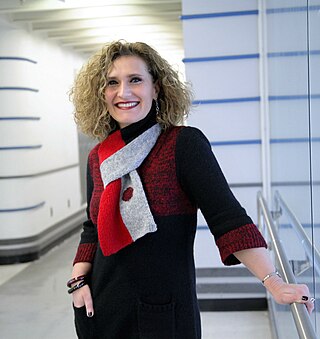
The National Institutes of Health, commonly referred to as NIH (initialism), is the primary agency of the United States government responsible for biomedical and public health research. It was founded in the late 1880s and is now part of the United States Department of Health and Human Services. Many NIH facilities are located in Bethesda, Maryland, and other nearby suburbs of the Washington metropolitan area, with other primary facilities in the Research Triangle Park in North Carolina and smaller satellite facilities located around the United States. The NIH conducts its own scientific research through the NIH Intramural Research Program (IRP) and provides major biomedical research funding to non-NIH research facilities through its Extramural Research Program.
The National Institute of Mental Health (NIMH) is one of 27 institutes and centers that make up the National Institutes of Health (NIH). The NIH, in turn, is an agency of the United States Department of Health and Human Services and is the primary agency of the United States government responsible for biomedical and health-related research.

The National Institute on Drug Abuse (NIDA) is a United States federal government research institute whose mission is to "advance science on the causes and consequences of drug use and addiction and to apply that knowledge to improve individual and public health."

Rimcazole is an antagonist of the sigma receptor as well as a dopamine reuptake inhibitor. Sigma receptors are thought to be involved in the drug psychosis that can be induced by some drugs such as phencyclidine and cocaine, and rimcazole was originally researched as a potential antipsychotic with a different mechanism of action to traditional antipsychotic drugs. Trials proved inconclusive and rimcazole was not pursued for this application, but other sigma antagonists continue to be researched for a variety of potential applications. Rimcazole has been shown to reduce the effects of cocaine, and analogues of rimcazole have been shown to be highly effective at blocking the convulsions caused by cocaine overdose in animal models.
Richard B. Rothman is a pharmacologist who received his MD and Ph.D. degrees in pharmacology from the University of Virginia in 1982. Currently he is a senior investigator in the clinical pharmacology section of the National Institute of Drug Abuse's Intramural Research Program. In addition he is a board certified psychiatrist and medical director of the BeLite Medical Centers. His expertise is in studying the opioid system and the monoamine transporters as well as drugs acting on them, such as monoamine releasing agents.
Philip Salvatore Portoghese is an American medicinal chemist who has made notable contributions to the design and synthesis of ligands targeting opioid receptors. He is a Distinguished Professor of Medicinal Chemistry at the University of Minnesota, Twin Cities. He also served as the Editor-in-chief of the Journal of Medicinal Chemistry from 1972 to 2012, when the job was taken on by his departmental colleague, Gunda I. Georg, who shares the Editor-in-chief position with Shaomeng Wang at the University of Michigan.

The NIH Intramural Research Program (IRP) is the internal research program of the National Institutes of Health (NIH), known for its synergistic approach to biomedical science. With 1,200 Principal Investigators and over 4,000 Postdoctoral Fellows conducting basic, translational, and clinical research, the NIH Intramural Research Program is the largest biomedical research institution on earth. The unique funding environment of the IRP facilitates opportunities to conduct both long-term and high-impact science that would otherwise be difficult to undertake. With rigorous external reviews ensuring that only the most outstanding research secures funding, the IRP is responsible for many scientific accomplishments, including the discovery of fluoride to prevent tooth decay, the use of lithium to manage bipolar disorder, and the creation of vaccines against hepatitis, Hemophilus influenzae (Hib), and human papillomavirus (HPV). In addition, the IRP has also produced or trained 21 Nobel Prize-winning scientists.

Susan G. Amara is an American professor of neuroscience and is the Scientific Director of the National Institute of Mental Health. Dr. Amara is an elected member of the National Academy of Sciences and a fellow of the American Association for the Advancement of Science. She is a Past-President of the Society for Neuroscience. Dr. Amara has a B.S. in Biological Sciences from Stanford University and a Ph.D. in Physiology and Pharmacology from the University of California, San Diego.

Marta Filizola is a computational biophysicist who studies membrane proteins. Filizola's research concerns drug discovery the application of methods of computational chemistry and theoretical chemistry to biochemical and biomedical problems.
Nancy Rutledge Zahniser was an American pharmacologist, best known for her work involving the mechanism of dopaminergic pathways and chemical modifications of them. Although born in Ann Arbor, Michigan, Zahniser grew up in Chillicothe, Ohio and subsequently enrolled at the College of Wooster, where she obtained a degree in chemistry. After completing her degree, Zahniser spent some time in India where she met her first husband Mark Zahniser; she later returned to the United States to attend the University of Pittsburgh School of Pharmacy, where she earned her PhD in pharmacology in 1977. Zahniser went on to complete her post-doctoral training at the University of Colorado Health Sciences Center's Department of Pharmacology and then became a part of the faculty there. In 2007, she became associate dean for research education. She played a role in advancing the careers of many post-doctoral students in her lab. In addition to her work as a professor, Zahniser was also a member of several boards, committees, review panels, and professional societies related to pharmacology, neuroscience, and addiction. She led several national research meetings from 1995-2002.
Alexandros Makriyannis is an American biochemist and professor of Chemistry and Chemical Biology in the Department of Medicinal Chemistry at Northeastern University in Boston, Massachusetts, where he directs the Center for Drug Discovery and holds the George Behrakis Chair of Pharmaceutical Biotechnology. His research has focused on the biochemical basis of the endocannabinoid system and on the development of synthetic cannabinoids.

Lindsay M. De Biase is an American neuroscientist and glial biologist as well as an assistant professor at the David Geffen School of Medicine at the University of California, Los Angeles. De Biase explores the diversity of microglia that exist within the basal ganglia circuitry to one day target regional or circuit-specific microglia in disease. De Biase's graduate work highlighted the existence and roles of neuron-OPC synapses in development and her postdoctoral work was critical in showing that microglia are not homogenous within the brain parenchyma.
Anabella P. Villalobos is a medicinal chemist and senior pharmaceutical executive at Biogen.

Jean Lud Cadet is a Haitian-American psychiatrist at the National Institute on Drug Abuse (NIDA), where he serves as National Institutes of Health Chief of the Molecular Neuropsychiatry Research Branch. His research considers the genetic, epigenetic and cellular bases of substance abuse. In 2020 he was selected as one of Cell Press' Most Inspiring Black Scientists in America.
Amy M. Barrios is an American medicinal chemist working as a professor of Medicinal Chemistry and the Associate Dean for Postdoctoral Affairs for the University of Utah. Barrios’ research lab focuses on developing probes to study protein tyrosine phosphatase (PTP) activity and regulation.
Myriam Gorospe is a Spanish scientist, the head of the RNA Regulation Section at the National Institute on Aging (NIA) since 1998. Her group studies the influence of RNA in cellular processes related to aging.

Lauren Y. Atlas is an American psychologist researching how expectations and learning influence pain and emotion, and how these factors influence clinical outcomes. She is a clinical investigator at the National Center for Complementary and Integrative Health and serves as the chief of the section on affective neuroscience and pain.

Marisela Morales is a Mexican neuroscientist specializing in the neurobiology of drug addiction. She is a senior investigator at the National Institute on Drug Abuse.
Cynthia Dunbar is an American scientist and hematologist at the National Heart Lung and Blood Institute (NHLBI), which is part of the National Institutes of Health (NIH). She is the Branch Chief of the Translational Stem Cell Biology Branch.

Nina Felice Schor is an American physician-scientist and pediatric neurologist. She has served as director of the NIH Intramural Research Program since the Fall of 2022. Schor was the deputy director of National Institute of Neurological Disorders and Stroke from 2018 to 2022. She was the William H. Eilinger Chair of the Department of Pediatrics at University of Rochester and Pediatrician-in-Chief of the Golisano Children’s Hospital from 2006 to January 2018.











